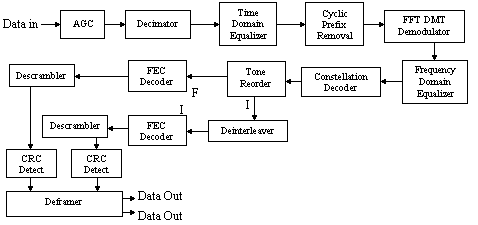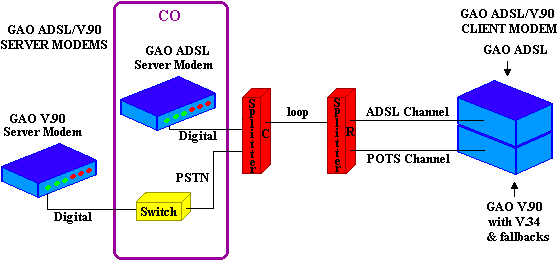High Speed Access Technology for the Last Mile: Integrated ADSL/V.90 Modem ICSPAT Conference, September 1998
GAO Research Inc.
Introduction
ADSL is now being used to provide higher bit rates over the copper pair in order to increase the speed of access for the last mile to the home. The ADSL modem offers extremely high bit rates of up to 8 Mbps downstream and 640 kbps upstream through the data channel. It also provides a POTS channel for either a telephone or a V-series modem. Tests at many telephone companies have proved that ADSL technology is practical and many North American telephone companies have already rolled out commercial services. As consumers continue to demand higher capacity access technologies for Internet applications and ADSL technology matures and becomes more ubiquitous, the ADSL modem will become the driving force of the modem market.
There are also reduced rate DSL technologies that have become popular including ADSL Lite, Universal ADSL, and Consumer DSL as well as proprietary technologies. For example, GAO Research and Consulting Ltd. has developed a reduced-rate ADSL modem which is compliant with the American National Standards Institute (ANSI) T1.413 standard but runs at 1.5 Mbps downstream and 500 kbps upstream. It can also be easily modified to be compliant with the G.Lite standard when it is ratified. The GAO modem (called GAO ADSL/V.90) also integrates V.90 functions. This integration will be discussed in a later section.
ADSL Standards
In 1995, ANSI approved Issue 1 of its ADSL DMT standard (T1.413) with an annex contributed by the European Technical Standards Institute (ETSI). The latest version of the ANSI T1.413 ADSL standard is Issue 2, which was released in 1998). The main changes from T1.413 Issue 1 to Issue 2 are as follows:
- Rates > 8 Mbps are now provided for;
- Transport of a network timing reference is specified;
- Reduced overhead modes are defined;
- Loop timing is made mandatory and some activation and acknowledgment signals are changed to facilitate it;
- State machines are defined for both ATU-C and ATU-R;
- An expanded initialization sequence is added to enable rate adaptation.
The International Telecommunications Union (ITU) is now working toward a G.dmt standard for ADSL which is modeled after ANSI T1.413 Issue 2 and ETSI Technical Report 328. A G.Lite standard from the ITU is also on the way.
ADSL Principles
ADSL modems, as specified in the ANSI and ITU standards, make use of technology that is very different from ITU V-series modems.
ANSI ADSL uses the Discrete Multi-Tone (DMT) technique. The DMT line code sends multiple tones of data over the line allocating more data to the lower frequencies where there are less analog impairments.
ADSL modems also split incoming data into two streams – a fast stream and an interleaved stream. Interleaving a portion of the data facilitates error correction by giving protection against noise bursts at the cost of higher latency. This means that some of the components are doubled, one for the fast stream and one for the interleaved stream. This is illustrated in Figures 1 and 2.
Modulation:
The IFFT modulator combines many QAM constellations. The channel analysis signal allows the use of a maximum of 255 carriers [at frequencies nf (n = 1 to 255, f = 4.3125 kHz)]. In reality, about 225 carriers or channels are usable. The lower limit on n is determined by the ADSL/POTS splitting filters if echo canceling separates the downstream and upstream signals; however, if frequency division multiplexing is used, then the down-up splitting filters set the lower limit. The cut-off frequencies of these filters are defined by the designer because channel estimation determines the range of usable n.

Figure 1: Transmitter of the ADSL Modem
1. Transmitter
The ANSI ADSL standard specifies the main parts of the ADSL transmitter, which is illustrated in Figure 1. Five main components of the ADSL transmitter are described below.
Cyclic Prefix:
The length of the cyclic prefix constitutes the guard band. If the channel’s impulse response time is shorter than the cyclic prefix, then use of the cyclic prefix results in DMT symbols that are free of inter-symbol interference.
It is interesting to note that the downstream transmission of 225 QAM constellations is equivalent to approximately 225 V.34 (simplex) modems running in parallel.
Constellation Encoder:
This encoder is similar to V.series modem quadrature amplitude modulation (QAM) encoders. One way to improve system performance is the block processing of Wei’s 16-state, 4-dimensional trellis code. An algorithmic constellation encoder constructs QAM constellations with a maximum of 15 bits per DMT channel (10 bits per channel is approx. = a V.34 constellation).
Encoder/Interleaver:
The interleave buffer convolutionally interleaves the Reed-Solomon codewords. The depth of the interleaving varies, but it is consistently a power of 2. The FEC coding can reliably correct occasional errors if the tones with the greatest number of bits are allocated to the interleave buffer.
Scrambler:
The following algorithm is used to scramble separate output from both the fast and interleaved buffers.
where dn is the n-th output from the fast or interleaved buffer (scrambler input), and dn’ is the n-th output from the corresponding scrambler. Both the scrambler and descrambler are self-synchronizing.
2. Receiver
The ANSI standard does not specify the receiver in as much detail as the transmitter, giving the modem designer a great deal of flexibility. A typical design of the receiver is illustrated in Figure 2. Many of the receiver functions such as the cyclic prefix removal, demodulator, decoder, descrambler, and deinterleaver perform the inverse of the transmitter functions. Those components unique to the receiver include the time domain equalizer, frequency domain equalizer, and automatic gain control. The job of some of the receiver functions in an ADSL modem is to recover and process the transmitted signal for presentation to the demodulator. The demodulator’s task is to retrieve the digital bits that form the transmitted message.

Figure 2: Receiver of the ADSL Modem
ADSL Principles
The integration of ADSL and V.90 modems is made possible by the POTS channel that ADSL technology provides. This integration technique, used by GAO ADSL/V.90 from GAO Research and Consulting Ltd., can be applied to both splitter based ADSL which complies with the ANSI T1.413 standard and splitterless ADSL which will comply with the forthcoming G.Lite standard. As illustrated in Figure 3, ADSL channel splitting gives wide bandwidth for Internet applications and doesn’t affect regular telephone service. The V.90 modem function offers bit rates of up to 56 kbps downstream and 33.6 kbps upstream. It makes use of the POTS channel and serves as a fallback if the ADSL service fails or is not available. Telephone service may also be accessed through the POTS channel if the V.90 modem is not used.
V.90 technology takes advantage of the fact that digital transmission facilities have been rapidly replacing analog transmission facilities on the Public Switched Telephone Network (PSTN). Because Internet service providers (ISP) are digitally connected both to the Internet and to a telephone company抯 central office (CO), a conversion from digital to analog lines in the connection from ISP to CO is avoided.
The V.90 downstream connection is extended from the CO to the user via a line card with a digital to analogue converter (DAC) providing a pulse amplitude modulation (PAM) analog signal to the user modem. The downstream signal consists of 8,000 symbols per second with each symbol maximally coded from 7 bits of each 8 bit pulse code modulation (PCM) word. This translates into 128 possible amplitude levels in the PAM signal. Data rates of up to 56 kbps are the result. V.34 analog transmission techniques are used in the upstream direction.

Figure 3: Integration of ADSL & V.90
Whether integrated with V.90 or not, OEMs must make sure ADSL products are upgradable to the final version of the ITU G.dmt standard. They also need to get their products to market quickly in order to gain a large market share. Software implementations of ADSL modems will be much easier to upgrade than hardware implementations. If the decision is made to go with a software implementation of ADSL, OEMs must either design that software in-house or license it from a software vendor. Modem software is extremely complicated and requires a great deal of expensive engineering time to develop. Time to market is critical in the modem industry – if a product is released too late, customers will have lost interest in favor of the next version. Thus, licensing software is the fastest and least expensive option for OEMs developing ADSL modems.
Characteristics to look for if you are licensing modem software:
- It must comply with the current or draft standard and be upgradable to the final standard.
- The software must be tested according to the appropriate standards.
- It must use the least possible memory and MIPS.
In order to reduce memory and MIPS requirements, ADSL modems such as GAO ADSL/V.90 can run at reduced rates on today抯 processors. As processors get faster and more powerful, it will become feasible to upgrade and run full-rate ADSL software modems.
Conclusion
As consumers continue to demand higher capacity access technologies for Internet applications and ADSL technology matures and becomes more widespread, the ADSL modem will become the driving force of the modem market. This is more likely now that the American National Standards Institute (ANSI) has approved an ADSL DMT standard (T1.413 Issue 1) with an annex contributed by the European Technical Standards Institute (ETSI) and the ITU is working toward a G.dmt standard for ADSL. Standard ADSL uses the Discrete Multi-Tone (DMT) technique. ADSL modems also split incoming data into two streams – a fast stream and an interleaved stream. The integrated ADSL/V.90 modem from GAO makes full use of the multi-channel feature offered by the ADSL technology, which provides a data channel and a POTS channel. Whether integrated with V.90 or not, OEMs must make sure ADSL products are upgradable to the final version of the ITU G.dmt standard and licensing software is the fastest, least expensive, and most upgradable option for achieving that.
About the Author
Alan Marion has been a senior engineer at GAO Research Inc. for the past 3 years. He has over 20 years experience in telecommunications and electronics. Alan has a B.A.Sc. in Electrical Engineering from the University of Toronto. Mr. Marion can be reached at: T (416)292-0038, F (416)292-2364, alanm@gaoresearch.com.
